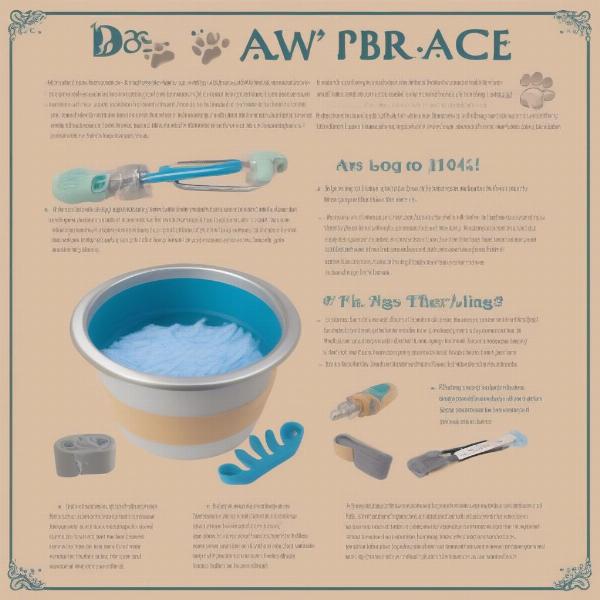Dog paw braces are becoming increasingly popular among dog owners seeking to protect their furry friends’ paws from injury, discomfort, or further aggravation of existing conditions. Whether your dog is recovering from surgery, suffering from arthritis, or simply needs extra support during strenuous activities, a dog paw brace can provide significant benefits. This guide will delve into everything you need to know about dog paw braces, from choosing the right type to ensuring a proper fit.
Understanding the Need for a Dog Paw Brace
Several conditions may necessitate the use of a dog paw brace. These can range from acute injuries like cuts, sprains, and fractures, to chronic conditions such as arthritis, degenerative joint disease, and hyperextension. Even healthy dogs can benefit from paw braces during activities like hiking or running on rough terrain, providing extra support and preventing potential injuries.
Common Reasons for Using a Dog Paw Brace
- Injury: Braces can stabilize injured paws, limiting movement and promoting healing.
- Arthritis: Providing support and compression can alleviate pain and improve mobility in dogs with arthritis.
- Post-Surgery: Braces help protect surgical sites and restrict movement to prevent re-injury.
- Knuckle Support: Braces can provide crucial support for weakened or unstable knuckles.
- Protection: During outdoor activities, braces can shield paws from sharp objects, hot surfaces, and rough terrain.
Choosing the Right Dog Paw Brace
The ideal dog paw brace will depend on your dog’s specific needs. Consider the following factors when selecting a brace:
- Type of injury or condition: Different braces offer varying levels of support and immobilization.
- Size and breed of your dog: Ensure the brace is appropriately sized for your dog’s paw.
- Material and design: Look for breathable, durable materials that offer comfort and flexibility.
- Ease of application and removal: A brace that is easy to put on and take off will simplify the process for both you and your dog.
Ensuring a Proper Fit
A properly fitted dog paw brace is crucial for effectiveness and comfort. A brace that is too loose may slip and fail to provide adequate support, while a brace that is too tight can restrict circulation and cause discomfort.
Tips for Fitting a Dog Paw Brace
- Measure your dog’s paw: Follow the manufacturer’s instructions for accurate measurements.
- Start with a loose fit: Gradually tighten the brace until it is snug but not restrictive.
- Monitor your dog’s comfort: Observe your dog for signs of discomfort or restricted circulation.
- Consult with your veterinarian: If you are unsure about the proper fit or type of brace, seek professional advice.
Caring for Your Dog’s Paw Brace
 Cleaning and maintaining a dog paw brace
Cleaning and maintaining a dog paw brace
Proper care will extend the lifespan of your dog’s paw brace and ensure its effectiveness.
- Clean the brace regularly: Follow the manufacturer’s cleaning instructions.
- Check for wear and tear: Replace the brace if it becomes damaged or worn.
- Store the brace properly: Keep the brace in a dry, cool place when not in use.
Expert Insights
Dr. Emily Carter, a renowned veterinary orthopedic surgeon, emphasizes the importance of proper brace selection: “Choosing the right brace is essential for successful treatment. A poorly fitted or inappropriate brace can exacerbate the condition and delay healing.”
Dr. Sarah Miller, a certified canine rehabilitation therapist, adds, “Introducing the brace gradually and positively reinforcing your dog’s acceptance can make the process easier and less stressful for both of you.”
Conclusion
Dog paw braces can be a valuable tool in managing various paw conditions and injuries. By choosing the right brace, ensuring a proper fit, and providing adequate care, you can help your canine companion regain comfort and mobility. Remember to consult with your veterinarian for personalized advice and guidance.
FAQ
- How long should my dog wear a paw brace? This depends on the specific condition and your veterinarian’s recommendations.
- Can my dog swim with a paw brace? Most braces are not designed for swimming.
- Are there different types of braces for different paws? Yes, there are braces designed for front and hind paws, as well as specific braces for different joints.
- How can I get my dog used to wearing a paw brace? Introduce the brace gradually and reward your dog for positive behavior.
- What should I do if my dog chews on the brace? Consult with your veterinarian, as chewing can damage the brace and potentially harm your dog.
- Are there alternatives to paw braces? Your veterinarian can discuss alternative treatment options, such as medication or physical therapy.
- How much does a dog paw brace cost? The cost varies depending on the type, size, and brand of the brace.
ILM Dog is your trusted source for all things canine. We offer expert advice and resources on dog breeds, health, training, nutrition, grooming, and much more. Whether you’re a seasoned dog owner or just starting your journey with a furry friend, ILM Dog is here to support you every step of the way. Contact us at [email protected] or +44 20-3965-8624 for personalized assistance. Learn more about us at ILM Dog.